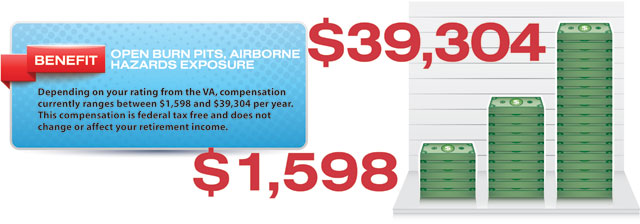Quiz-summary
0 of 3 questions completed
Questions:
- 1
- 2
- 3
Information
• Reduced central nervous system function
• Reduced liver or kidney function
• Stomach, respiratory, or skin cancer
• Leukemia
• Upper or lower respiratory system conditions
• Cardiovascular conditions, among others
You have already completed the quiz before. Hence you can not start it again.
Quiz is loading...
You must sign in or sign up to start the quiz.
You have to finish following quiz, to start this quiz:
Results
Time has elapsed
Categories
- Not categorized 0%
-
Your answers to this rapid assessment questionnaire show you may not meet the criteria for VA benefits and entitlements for airborne hazards during military service.
However, the list of illnesses and medical conditions presented in this rapid assessment does not include all possible medical and health-related conditions and the period of your active duty service may apply to one of the many exceptions in the regulations.
Average compensation ranges from $1,598 to $39,304 per year, depending on your illness and rating. The 1.5 million Gulf War-era veterans receiving compensation in 2013 were paid an average of $11,756. This compensation is federal tax free and does not change or affect your retirement income, including military or federal civil service retirement or Social Security income.
View our comprehensive section on burn pit exposure here >
-
 Your answers to this rapid assessment questionnaire show that you may be entitled to compensation or other VA benefits and entitlements due to airborne hazard exposure during military service. You may have other diagnosed diseases, illnesses, or conditions not listed in the quiz that you believe may be linked to your active duty service. It is important to note that the VA currently says exposure to burn pits during service “does not show evidence of long-term health problems.”
Your answers to this rapid assessment questionnaire show that you may be entitled to compensation or other VA benefits and entitlements due to airborne hazard exposure during military service. You may have other diagnosed diseases, illnesses, or conditions not listed in the quiz that you believe may be linked to your active duty service. It is important to note that the VA currently says exposure to burn pits during service “does not show evidence of long-term health problems.”However, veterans may submit a claim for health problems they believe are related to exposure to burn pits. The VA decides these claims on a case-by-case basis, and the burden of proof lies with the veteran to make the service connection. Also, be sure you have signed up on the VA’s Airborne Hazards and Open Burn Pit registry to document your exposure, schedule an exam, and learn about follow-up care.
The 1.5 million Gulf War-era veterans receiving compensation in 2013 were paid an average of $11,756. Average compensation for exposure ranges from $1,598 to $39,304 per year, depending on illness or condition and VA disability rating.
This compensation is federal tax free and does not change or affect your retirement income, including military or federal civil service retirement or social security income.
Also, it is important to monitor VetsHQ for any deadlines for signing up on the Airborne Hazards and Open Burn Pit registry to document your exposure, schedule an exam, and learn about follow-up care.
View our comprehensive section on burn pit exposure here >
- 1
- 2
- 3
- Answered
- Review
-
Question 1 of 3
1. Question
Check all of the conditions that apply to you:
-
Question 2 of 3
2. Question
During my deployment, I was (check all that apply):
-
Question 3 of 3
3. Question
I currently have health conditions like (check all that apply):
